Trade as an asset class: A troublesome best friend?
What is stopping trade finance becoming an easy-to-buy-and-sell asset class? For all the hype, what continues to turn something that should be straightforward into something so complex? TXF investigates.

“Outside a dog, a book is a man’s best friend. Inside a dog, it’s too dark to read.” That was Groucho Marx. This is trade finance. It is both simple, and opaque.
Outside of bank investors, trade asset receivables have had something of an image problem. Inside bank investors, trade asset receivables, which for a while used to be seen as a huge asset class by banks, funded by commercial paper (CP) and backed off banks’ balance sheets by bank liquidity facilities in what were known as ‘conduits’. That was then, before the global financial crisis (GFC). Now, banks, the largest investors in trade asset receivables, certainly don’t want to hold them on their books (they never really did). So what went wrong, what are the troubles of turning trade exposures into investable assets, who wants to buy trade assets, and who should?
What went wrong?
“Now the regulators have shut that door (rightly). The banks told the regulators that the liquidity facilities were not a direct credit substitute so they were off balance sheet, but they also told rating agencies and investors that the liquidity facilities were there to ensure repayment of the CP,” explains the CEO of one non-bank trade finance provider. “Both positions can't be correct. And bingo – when the piper came calling in 2008, the liquidity facilities were called and investors were protected. So now trade receivables in CP conduits are on balance sheet, well done the regulators.”
And that’s where Basel capital adequacy regulations started changing the picture. That means this is no longer a great asset class for banks and CP backed by trade receivables is much reduced in volume. Not only that, liquidity is also an issue (particularly dollar liquidity between markets), and banks do not want to warehouse trade receivables on their books. The regulatory capital return is not attractive any more.
“Therein lies the opportunity. No one has really cracked it yet. Somebody will. There are some very interesting projects out there,” the trade financier adds.
Says Ann Rutledge, CEO of Credit Spectrum in New York, “To me, the big opportunity is the free capital that falls between the cracks between accounting and rollover analysis based on the static pool. That opportunity was mined perversely and the GFC was the result....”
Who wants to buy?
Mark Evans, managing director of transaction banking at ANZ told TXF back in May: “It’s not an easy asset for investors to get their heads around. They start to understand, then waiver when they have to consider trade documentation/fraud/commercial risks. It’s not always ‘clean’ enough in their eyes or leaves them or their accountants uncomfortable if it is not hypothetically completely without recourse. Even the letter of credit (LC) is still subject to fraud or commercial dispute. Insurers and some investors have an appetite but the market is not moving as fast as people will have you believe.”
If investors don’t understand trade assets. Why don’t they? For one thing, potential investors can’t see trade assets on a Bloomberg screen, and as Robert Kowit (formerly at Federated Investors) told the ICC Banking Commission in Miami, “For financial investors if it’s not on Bloomberg it doesn’t exist.” There’s a lot that banks can do collectively to make trade assets more visible and improve education.
What actually are trade assets?
Let’s unpick this a bit. Trade assets come in many flavours, but one of the common denominators is that they are short term and self-liquidating debts between companies. That means that the trade asset generates the proceeds that are in turn used to pay for it. The trade transaction is the collateral for the financial transaction, therefore it might also be described as self-amortising.
Trade finance assets are receivables, that is loans, as far as a bank is concerned and supported by guarantees and other instruments. These trading instruments are vital to the functioning of corporates and the world economy, and as such, have been perceived as relatively low financial risk because they usually get paid because people want to buy and sell. That should make them the proverbial low risk ‘a man’s best friend.’ But those low risks aren’t readily quantifiable outside annual initiatives such as the ICC’s trade register. And the non-financial risks such as fraud that Evans refers to are another (important, and even more tricky to quantify) story for another article.
Typically, trade assets are formed from a variety of sources – from documentary credits (principally LCs), trade loans, pre and post export finance and guarantees. Definitions of what makes trade assets vary, and investors have to tackle them flavour by flavour. In an ideal world all trade assets would be of exactly the same sort. But it is not an ideal world. Vegetables rot, some metals rust and comparing tyres to cereals are, well, like comparing apples and pears (not a great analogy). You have to have certain sort of enhancement in terms of guarantee to make 30-day vegetables the same as 180-day exhaust pipes, and that’s the beauty of trade finance.
Banks can offload (aka distribute) these assets in three ways: straight sales, assignments, novations. And they have traditionally had three sets of buyers: other banks, private institutional investors and public institutional investors.
Outside of the bank space, origination of trade finance funds can be as clear as mud.
Frustrated enthusiasm for an asset class
David Gustin, Chief Strategy Officer at The Interface Financial Group says, “Talk about trade as an asset class is just marketing. This is a private placement market, with little or no transparency. I don’t need to sign an NDA [non-disclosure agreement] to buy a five year note off Bloomberg, but if you want to see my 45 page prospectus on how great this trade fund is, or note is, NDA up.” Gustin wrote The Tower of Babel and Trade Finance as an Asset Class last year in which he shared some of his frustration.
In this article, Gustin makes the important point that promoters of trade as an asset class know, but often forget to put across, that when it comes to trade finance receivables, the risk primarily lies in the contract, and not in the market.
And even for banks trying to distribute funds, WhatsApp as a form of price discovery is not the most transparent. Even for willing investors, transparency is not there. But transparency is only part of the challenge.
Gustin explains some of the problems potential investors face: “The work to buy [say] a two-year Vodafone note with a yield of x% on Bloomberg versus trying to buy a two-year synthetic note backed by a pool of Vodafone (+ other?) receivables, through a trust structure, although providing Y% yield (where say Y > X by 30bp) is a risk very, very few people can understand and assess. Investors just take this risk and assume all is ok. It’s really not about transparency, it’s really about the bespoke nature of these structures but the marketing pitch is these are great assets, etc. Most ‘investors’ do not have the staff to assess. There are very few asset managers that understand as well.”
Real money funds invest on ratings. Corporates are familiar with the ratings process, but a bond issue from one company will not be the same as looking at a trade finance asset from the company.
For sure, investors don’t, and shouldn’t, think of all forms of trade receivables in the same way.
“Part of what makes trade receivables difficult for new investors is the non-standard, private placement nature of the assets. It’s difficult for an investor to approach a 90-day asset with 200 pages of documentation that is different from every asset provider,” says Alex Seo, Investment Associate at Fermat Capital Management. “The assets themselves can be very attractive from a risk-reward perspective, but evaluating the risks can be daunting for investors that are new to the space, therefore the barrier to execution is high.”
Patches of light
There is increasing interest in attracting institutional investors who might like to invest in trade assets.
Tradeteq is one example of a digital endeavour which is in the process of developing platforms to put banks and investors together. It provides a measure of credit scoring, and is working with digital outfits such as Singapore’s Networked Trade Platform (NTP), the country's national trade information management platform.
Platforms such as Singapore’s CCRManager, which describes itself as a digital marketplace for secondary trade and working capital risk, aim to provide liquidity and transparency (to the extent that the providers of assets within the platform want that transparency). Within CCRManager, for instance, banks originate from a single client but then get a choice of options of what to sell down and to whom (banks, insurers, institutional investors).
Kah Chye Tan, CEO of CCRManager says: “For us as a community to continue to tap investors who are real money funds there are three things we need to overcome. First, one way or another the assets need to be rated. Number two, we need to have independent settlement capability and number three we need to have independent custodian capability. Without all three we will never be able to industrialise this process and truly tap into the liquidity that is available.”
Often, people talk about fund managers as if they are all the same. They are not, and they don’t act as a unit. On one level are the real money fund managers, pensions funds, sovereign wealth funds, insurance funds even family offices. At another level come the specialised asset funds, which have a more hands-on approach to the underlying transaction.
The first category tend to invest in highly liquid publicly rated assets. These institutional investors tend to invest in assets that have a rating from, say, Moody’s Investors Services, Fitch or S&P. Trade assets don’t have such ratings.
This type of investor tends to act at a remove from the underlying transaction.
This level of remove from the transaction results in two things that the institutional investor is reliant on. Firstly, settlement has to be done independently by an independent service agent. That means that if a bank sells down its trade assets, it continues to have to service the transaction. Secondly the custodian of the assets being sold has to be independent. In the case of a bank selling down its trade assets, they continue to be the custodian of the asset.
The second category, specialist asset funds, however, are less likely to be divorced from the underlying transactions. This latter category actually tend to operate more like a bank than the other funds.
Education, transparency, liquidity. These are all key for the future development of the market, but it can be frustrating when there is so little publicly available information.
It’s difficult to tell at what speed these markets will develop, but the space is certainly worth watching. That speed will depend upon the human and the inhuman. The latter is the technology and the level of security that can be relied upon. The human has to believe in the security of the technology and its own confidence in the quality of the offer, both in the technology and the underlying security of the transaction and the counterparties.





